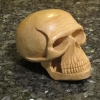Our koi carp is a mixture of sculptural form - in the smooth sweeping lines - and traditional carving - in the eye and fins. Also a bit of joinery - fitting the fins to the body. So, lots to do! But, as always, we'll take it step by step, starting at the beginning.
The koi is designed to hang on the wall just underneath its head and be looked at with its eyes a bit above the viewer's eye level. The impression is that we are gazing down on the fish as it lazily swims in a pond.
The download (link below) contains working drawings and notes about tools, holding and other things I mention in the lessons. Although I carve the fish at a particular size, you can of course make it smaller or larger according to what wood you have. You can even make the koi more 'bendy', but do consider wood strength in the thin tail end and ensure you maximise the length of your wood fibres here.
Some links to useful lessons:

| 14 November 2023 21:57
Richard - It's made in the UK by Spencer-Franklin - and called a 'Hydroclamp'
Put 'Franklin Spencer Hydroclamp' in Google - images.
And here's one site:
https://www.wdscomponents.com/en-gb/our-brands/spencer-franklin

| 12 November 2023 19:07
Your swivelling stand - who makes it and what might be an official name for it?

| 12 January 2020 19:58
Jerome - Thanks very much for your generous comments!
This Koi is quite 3 dimensional and that's a big part of the impact. You can of course make it out of any thickness wood but you need to keep to the proportions. So if you, say, have half the thickness I use here, you'd scale the pattern to half size (length etc) and you'll end up with a smaller fish proportionally correct - and that could be just fine. With your 4in. board you can work out the size of Koi that you'll end up with - the profile on the wall.
However, since you have the wood - and if you have a wall high enough - I'd join up and go for big!

| 12 January 2020 05:56
Hi Chris,
I love your woodcarving. Truly amazing pieces of art. Your instruction methods and clarity are unsurpassed in both content and form. That all being said, I am embarking on carving this Koi. Can it be done in 4" thickness? What should be adjusted to do so? Or is it better to glue up boards? I prefer to do it in one piece. I have alot of 4" lime I want to put to good use.
Cheers!

| 19 February 2018 11:34
ok thanks for the advice and encouragement but I think it will be hardly better than yours as you say will definitely be the best I can do. thanks again a greeting Umberto

| 19 February 2018 09:01
Pennesi - I'm afraid that's not possible, the fish has long since swum away... But don't forget that you can freeze the videos at any point and take a screenshot when there is a side view.
Even better, get yourself a small piece of plasticine or clay and make a model of the body of the carp. (Add the fins if you want to of course ) Your carp does not have to be the same as mine. Your model will help you visualise the lines you are after and your carp may well look better than mine!

| 18 February 2018 11:23
hi chris it is possible to have a side picture of the carp. I started to sculpt it, but I do not know when the line should be deep from head to tail. thank you

| 17 January 2018 18:47
Derek - I shortened the screw myself. It's not too difficult. Cut it square to the length you want. Then file one flat face about 1/2" (14mm) long in the same plane as the axis of the screw. Then file an equal, parallel face on the opposite side. Then the two faces at right angles. Thus you file a square, removing the screw threads. Go carefully and check the dimension of the hole in the fly until it fit snug to the end of the screw and, voila, there you are...

| 11 January 2018 20:46
Hello Chris,
I really like the longer videos & the longer shots of you carving - thank you & Carrie for including them - the videos are even more fantastic (if that's even possible).
I have a question about the shortened Stubai screw: did you have a firm modify (shorten) the screw for you?
It makes me wonder because of the high quality make of the Stubai screw that modifying the top end (to receive the wrench/handle) or the exacting specs of the wood threaded end would be quite complicated. The benefits of having a shortened version of the amazing, versatile Stubai Carver's screw are very apparent to me & having the useful 7" & 9" screws are great, though there are some applications where a shortened version would be ideal.
Thanks,
Derek

| 26 October 2017 05:58
Irwin - It has to be down to the quality of the wood - the harder the better - and the quality of the sanding:
1. Work your way patiently though the grits - don't start off too coarse and don't press too hard
2. Fully remove the marks of the previous sanding
3. And always finish off WITH the grain.
4. And vacuum or brush of previous grit thoroughly between sandings
5. After the finest grit, damp surface and re-sand with finest grit.
That should do the trick!

| 25 October 2017 22:31
Just one question how do you create such a smooth and shining carving? I sand and sand but have no luck using Basswood.